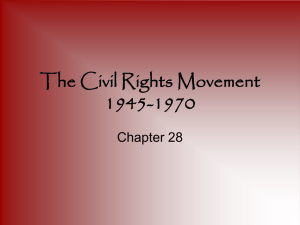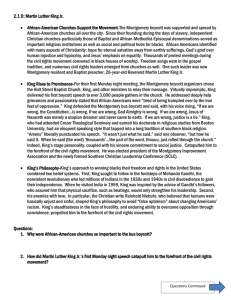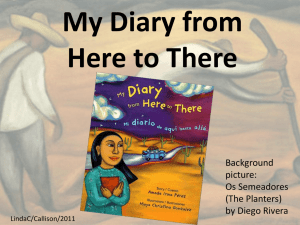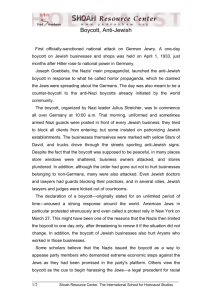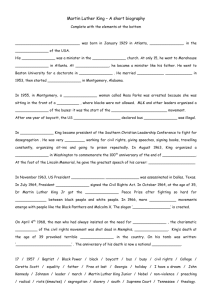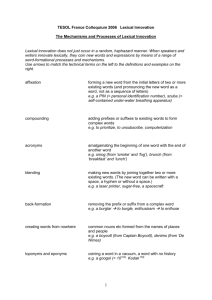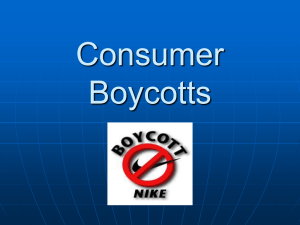1765 Stamp Act
advertisement
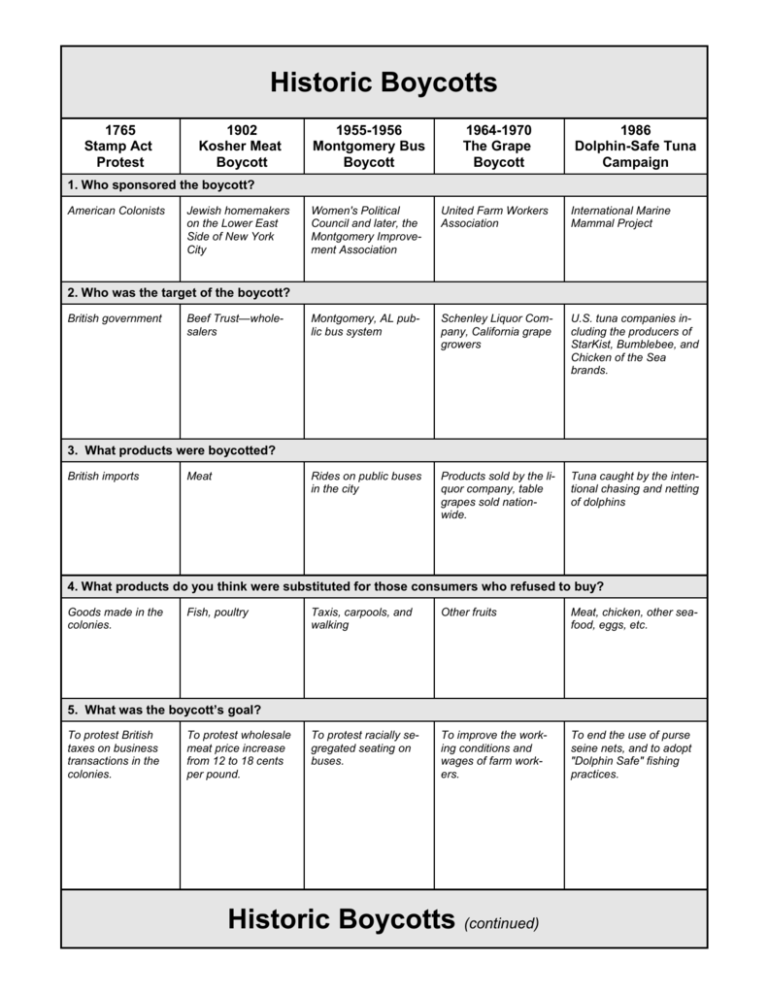
Historic Boycotts 1765 Stamp Act Protest 1902 Kosher Meat Boycott 1955-1956 Montgomery Bus Boycott 1964-1970 The Grape Boycott 1986 Dolphin-Safe Tuna Campaign Women's Political Council and later, the Montgomery Improvement Association United Farm Workers Association International Marine Mammal Project Montgomery, AL public bus system Schenley Liquor Company, California grape growers U.S. tuna companies including the producers of StarKist, Bumblebee, and Chicken of the Sea brands. Rides on public buses in the city Products sold by the liquor company, table grapes sold nationwide. Tuna caught by the intentional chasing and netting of dolphins 1. Who sponsored the boycott? American Colonists Jewish homemakers on the Lower East Side of New York City 2. Who was the target of the boycott? British government Beef Trust—wholesalers 3. What products were boycotted? British imports Meat 4. What products do you think were substituted for those consumers who refused to buy? Goods made in the colonies. Fish, poultry Taxis, carpools, and walking Other fruits Meat, chicken, other seafood, eggs, etc. To protest racially segregated seating on buses. To improve the working conditions and wages of farm workers. To end the use of purse seine nets, and to adopt "Dolphin Safe" fishing practices. 5. What was the boycott’s goal? To protest British taxes on business transactions in the colonies. To protest wholesale meat price increase from 12 to 18 cents per pound. Historic Boycotts (continued) 1765 Stamp Act Protest 1902 Kosher Meat Boycott 1955-1956 Montgomery Bus Boycott 1964-1970 The Grape Boycott 1986 Dolphin-Safe Tuna Campaign 6. What other techniques were used to achieve the same goal? Lobbying British Government Butchers initially refused to sell meat, boycotts were accompanied by riots Federal lawsuits against bus segregation were filed. Worker strikes, a march to the state capital Lobbying the federal government for “Dolphin Safe” labels on tuna 7. Was the goal achieved? Tell why you think the boycott succeeded or failed. The Act was repealed in 1766. British merchants were as unhappy as the colonists. Prices dropped back to 14 cents per pound. Retailers and the public were supportive of the action. The U.S. Supreme Court ruled that segregated seating on public buses is unconstitutional. The boycott garnered national attention but the legal case was the determining factor. By 1970, many workers were unionized giving them the power to negotiate for improvements. The boycott received strong national support from the media and the public. 90% of the world’s canned tuna is now caught though “dolphin safe. Reported dolphin deaths dropped. Though the practice continues in some parts of Central and South America. A video and public support were key factors. 8. What third-parties that might have benefited by the boycott? (For example – consumers, workers, taxpayers, other businesses, governments) • Colonial produ- cers of goods that could be substituted for British imports. • Fisherman, poultry farmers, other sellers of mea alternatives. • Workers who learned strategies later used to protest pay and working conditions. • Taxis got new cus- tomers. • Media attention • Other fruit growers as consumers purchased substitutes. gave the civil rights movement increase public support and a new momentum. • Fisherman who fished for other seafood. • Farmers who produce substitutes. • Companies that used dolphin-friendly techniques. 9. What third parties that might have been harmed by the boycott? • British manufac- turers and colonial retailers of the imports. • The shippers that brought the goods to colonies. • Consumers who chose not to support the boycott and who wanted to purchase British imports. • Retail meat sellers. Consumers who chose not to support the boycott and who wanted to buy beef. • Persons in the street who by chance were caught up in the riots. • Taxpayers and the local governments that had to cover costs of policing during the riots and the resulting damage. Council for Economic Education • Employers whose employees had difficulty getting to work. • People who had their persons or property damaged by those opposed to the boycott agenda. • The state gained an image as racist. o Grocery stor es and others who distributed and sold table grap es from • Tuna fisherman.

